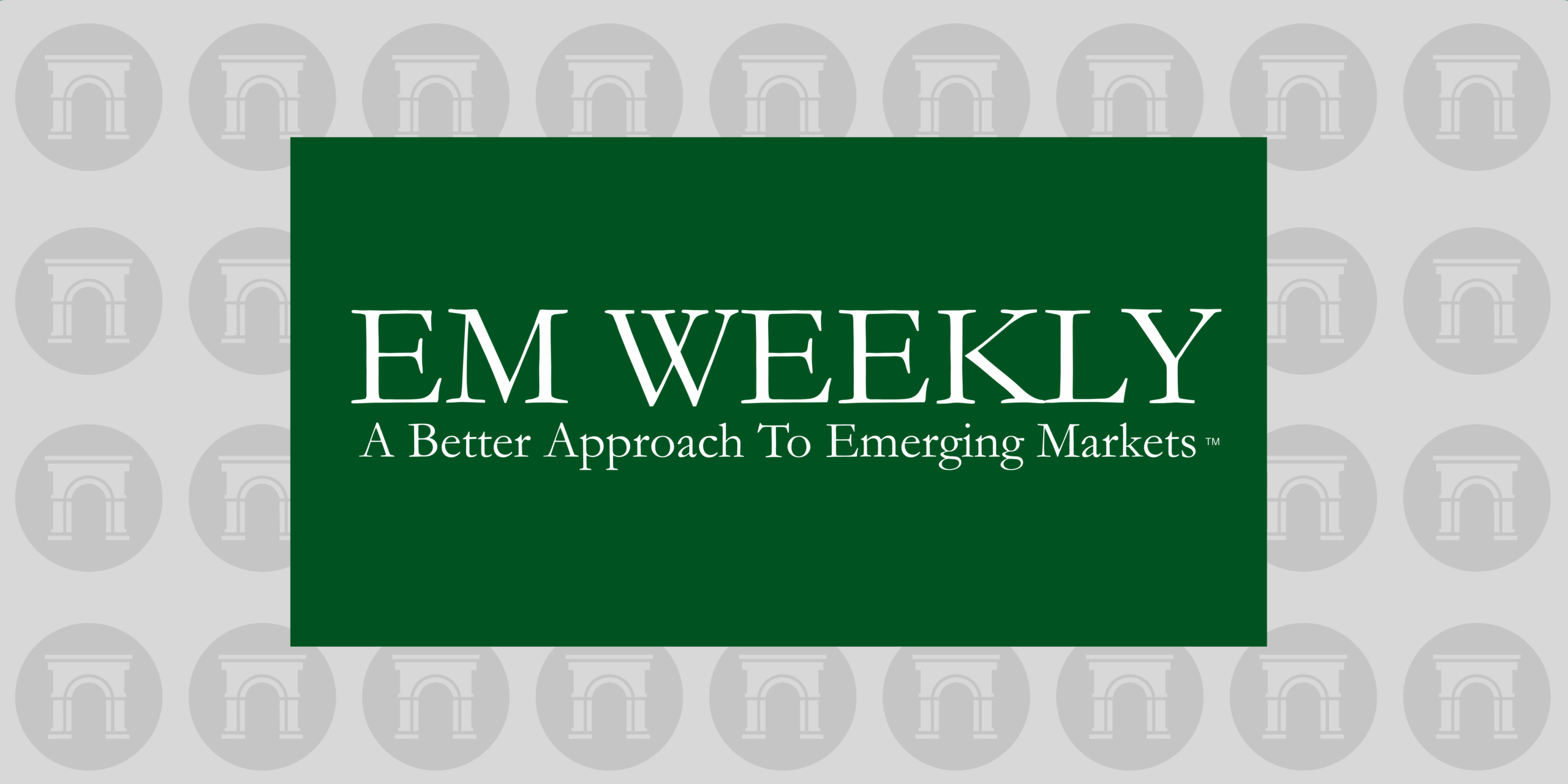Contents
Market Overview
Macro Update
U.S. trade policy was back in the spotlight this week. The Trump administration announced potential tariff increases on more than 20 countries, including a 50% levy on Brazilian exports and at least 25% on imports from key Asian partners such as Japan and South Korea. The proposed measures, set to take effect on Aug. 1st pending negotiations, are tied to a broad range of U.S. demands such as non-tariff barriers, digital rules, and market access in agriculture and autos. Notably, the inclusion of domestic political issues – such as Brazil’s prosecution of former President Jair Bolsonaro – adds a layer of complexity to the trade discussion. In addition, the White House suggested a 10% tariff on countries perceived to be aligned with “anti-American policies,” particularly within the BRICS bloc, which held its most recent summit in Rio de Janeiro. Copper futures also rose sharply, by nearly 20%, in response to the Trump administration’s proposed 50% tariff on the metal. This reflected concerns about potential supply disruptions and inventory buildup.
Global markets delivered a mixed performance this week: U.S. equities edged slightly lower, European indices posted more meaningful gains, and emerging markets broadly underperformed. Brazil’s IBOVESPA fell approximately 4%, weighed down by the Trump tariff posturing. In fixed income, U.S. Treasury yields increased, ending the week around 8-10bpshigher compared to last week, bringing 10-year and 30-year yields to approximately 4.40% and 4.95%, respectively. The dollar recovered marginally to around 98 on the DXY but remains in a structurally different position relative to the 110 where it started the year. Gold remains around recent highs (close to $3400 per oz.), while oil gained, with Brent and WTI around $70 and $68 per barrel, respectively.
On the policy front, the Federal Reserve remains in a data-dependent holding pattern. Minutes from the June FOMC meeting showed broad consensus around maintaining a cautious stance, while acknowledging diverging views on inflation’s path. Initial jobless claims came in lower than expected (227,000 vs. 235,000), reinforcing perceptions of labor market resilience and giving the Fed room to remain on pause. However, political pressure on Fed Chair Jerome Powell to lower interest rates is intensifying. President Trump has reiterated his support for rate cuts, and market speculation is growing around potential Fed leadership changes. Two names frequently cited as possible successors to Chair Powell – Kevin Warsh and Kevin Hassett – are both viewed as likely to favor a more accommodative policy stance, aligning with the president’s preferences.
In Europe, data releases painted a mixed but broadly stable picture. Eurozone retail sales rose 1.8% year-over-year in May, ahead of consensus, though the monthly decline was slightly larger than forecast. German industrial production rebounded strongly (+1.2% m-over-month), possibly reflecting front-loading by firms ahead of potential trade disruptions. German and French inflation was confirmed at 2.0% and 0.9% year-over-year, respectively, in June, aligning with earlier estimates. In the UK, month-over-month GDP in May came in weaker than expected (-0.1% vs. 0.1%), recording a second consecutive monthly contraction after -0.3% in April. May Industrial production also disappointed, contracting more than expected in both annual and monthly terms.
In China, economic signals remained subdued. Producer price deflation deepened in June (-3.6% year-over-year) while consumer inflation edged up modestly (+0.1%), driven by non-food goods. Expectations are building that Beijing may introduce further supply-side measures, particularly in sectors grappling with overcapacity.
Geopolitical developments also remained in focus. France and the UK announced new cooperation on nuclear deterrence, reflecting a broader shift toward greater European security coordination. The announcement came during French President Emmanuel Macron’s state visit to London, where he and UK Prime Minister Keir Starmer also emphasized the need to reduce economic dependence on both the U.S. and China.
Their discussions took place against the backdrop of the largest Russian aerial offensive on Ukraine since the start of the conflict. Meanwhile, Russia’s ground operations have gained pace, although at significant cost. In the U.S., President Trump reversed an earlier decision to pause certain military aid to Ukraine, and additional Russian sanctions are reportedly under discussion in the U.S. Senate. A proposed package would include secondary sanctions targeting major Russian energy importers – particularly China and India – potentially introducing further tension in global energy markets.
EM Credit Update
Emerging market (EM) hard currency sovereign debt posted a slight loss of 0.09% for the week, led by the high yield segment, which returned -0.14% vs. investment grade sovereigns, which were relatively flat on the week. Latin America and Eastern Europe underperformed this week, driven by weakness in high-beta names such as Argentina, Venezuela, and Ukraine, which were disproportionately affected by the market’s risk-off tone. The Middle East outperformed, supported by the relatively muted performance of investment-grade credits and positive sentiment around Lebanon. In Lebanon, authorities have begun pushing for Hezbollah’s disarmament and accelerating the implementation of reforms, which contributed to improved investor optimism. On a country level, Bolivia stood out as the top performer as the electoral court blocked former President Evo Morales from running for president again. This development renewed interest from hedge funds in this illiquid credit and helped drive prices higher.
EM local currency sovereign debt finally took a breather this week, with a negative return of 0.70%, as the dollar was supported by the prospects of higher rates for longer. On the country level, the main drag came from Brazil and Chile, as the market reacted in a knee-jerk fashion amid further confusion over the latest White House tariff threats for Brazil and for copper, Chile’s main export. Türkiye also underperformed amid renewed domestic political noise.
EM corporates outperformed both hard currency and local currency sovereigns this week, delivering a 0.08% return at the index level, with broadly similar performance across both investment-grade and high-yield segments (+0.09% and +0.06% for investment grade and high yield, respectively). Nonetheless, the C-rated corporate credit bucket outperformed this week, returning 0.89%. From a sector perspective, oil and gas outperformed on the back of oil price movements and metals and mining underperformed on the back of tariff concerns. Spreads remained stable, and market activity was relatively muted.
Primary issuance returned in earnest this week with 15 new deals across the sovereign and corporate space. Sovereign issuance included Guatemala, Romania and Türkiye.
The Week Ahead
Major data releases next week include U.S. inflation for June, which is expected to show an uptick and offer an initial glance into the effects of Trump trade policies on the economy. The Empire State Manufacturing Index, PPI, industrial production, retail sales, initial jobless claims, the Philadelphia Fed factory index, business inventories, housing starts, and the University of Michigan consumer sentiment survey are also on the docket, and the Fed will be releasing its Beige Book survey of economic conditions. Q2 earnings season kicks off with major Wall Street banks and consumer companies reporting.
In addition, China will report 2Q GDP as well as June retail sales and industrial production. Eurozone industrial production and CPI will be released, in addition to Germany’s ZEW survey expectations. The UK will publish jobless claims, unemployment and CPI, following a recent streak of soft economic data. June CPI numbers will also be released by Argentina, Sweden, Finland, India, Canada, Israel, Poland, Saudi Arabia, Spain, Italy, and Japan. 2Q GDP numbers are due in Singapore, Malaysia and Israel and Indonesia’s Central Bank will meet to set rates. EU trade ministers will meet in Brussels at a time of high uncertainty about U.S. tariff policies, while G20 finance ministers and central bank governors will gather in South Africa through July 18th; U.S. Treasury Secretary Scott Bessent is not expected to attend.
Fixed Income
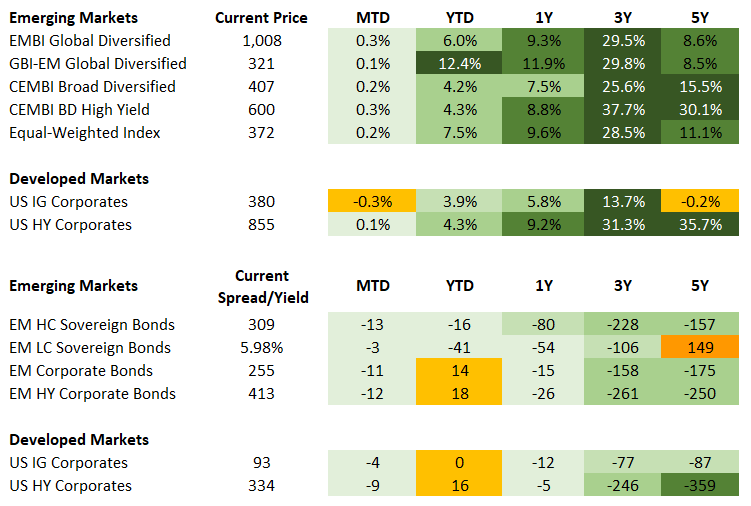
Equities
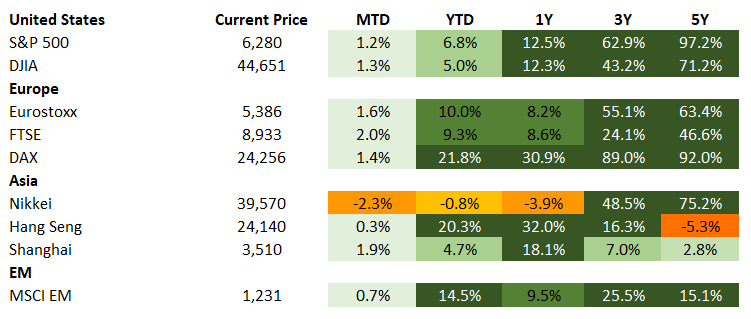
Commodities

Source for data tables: Bloomberg, JPMorgan, Gramercy. EM Fixed Income is represented by the following JPMorgan Indicies: EMBI Global, GBI-EM Global Diversified, CEMBI Broad Diversified and CEMBI Broad High Yield. DM Fixed Income is represented by the JPMorgan JULI Total Return Index and Domestic High Yield Index. Fixed Income, Equity and Commodity data is as of July 11, 2025 (mid-day).
Highlights
Brazil’s Domestically Driven Economy Can Withstand Higher U.S. Tariffs
Event: President Trump threatened to impose a universal 50% tariff on Brazilian imports to the U.S. if a set of conditions is not met by the new Aug. 1st deadline. In addition to economic and trade policy grievances, Mr. Trump listed the treatment of former Brazilian President Bolsonaro – facing trial for his involvement in an alleged coup attempt – as justification for the proposed tariffs. The White House also proposed an extra 10% tariff on countries aligned with “anti-American policies” by BRICS, an organization of emerging market economies in which Brazil is highly influential.
Gramercy Comment: The inclusion of a domestic legal matter such as Bolsonaro’s trial into trade negotiations is unusual and opens the door to further uncertainty for Brazil and other U.S. trading partners. Brazilian President Luiz Inácio Lula da Silva responded that his nation will not be “tutored” by anyone and said unilateral tariff increases will be dealt with under Brazil’s economic reciprocity law. While the size and scope of new trade barriers between the U.S. and Brazil is not yet clear, we see limited credit implications for Brazil at the sovereign level in the near-to-medium term. Brazil’s large economy (>$2.0 trillion) is one of the least “open” across emerging markets, with total imports and exports as share of nominal GDP at only around 35% vs. a median of 83% in relevant emerging market economies globally. Brazil’s domestic economic center of gravity is likely to shield it from the vacillations of the current global macro and trade environment, an important relative strength.
Moreover, amid continued dollar softness and questions about U.S. economic health, we expect emerging market assets, including Brazil’s, to remain relative winners. Furthermore, we are of the view that regardless of how the global trade drama evolves in coming months, Brazilian assets are likely to benefit from stronger idiosyncratic tailwinds on market optimism about potential market-friendly political change in the October 2026 general elections.
Romania Unveils Much Needed Fiscal Package
Event: The new Bolojan government launched a larger than anticipated fiscal package, comprised of a broad range of revenue and expenditure measures totaling roughly 5% of GDP through 2026, bringing the 2026 estimated deficit to around 6% of GDP. Adjustments include VAT hikes, higher dividend taxes, wage and pension freezes, and SOE reform. Following the announcement, the opposition launched a no-confidence vote. Romanian bonds rallied in the aftermath and the government issued $5.6 billion in new bonds denominated in dollars and euros.
Gramercy Comment: The swift action on fiscal consolidation post-election is constructive and reduces the risk of near-term ratings downgrades or delays in EU funding. We expect the government to survive the no-confidence motion given the ruling coalition’s majority in parliament – but acknowledge implementation is not without risk given political and social divisions and a 2025 deficit tracking at a wider-than-envisaged level. The tax hikes should drive a temporary inflationary spike in the near-term and likely keep the Central Bank on hold, but we expect local rates to remain better anchored amid lower fiscal risks.
Emerging Markets Technicals
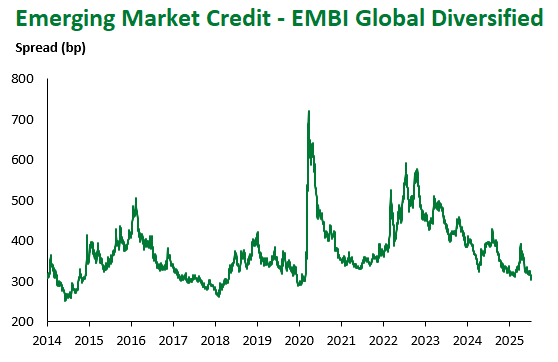
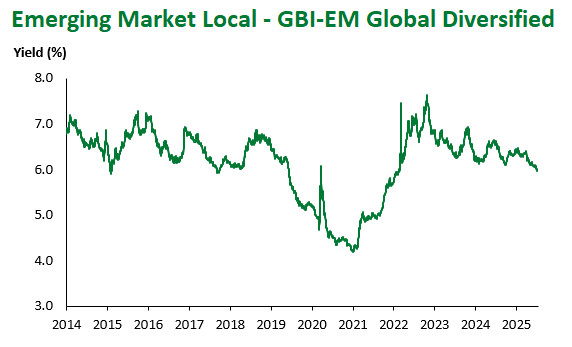
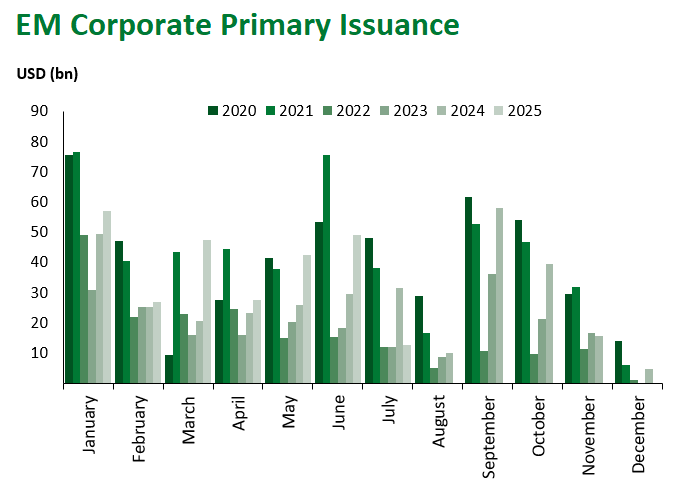
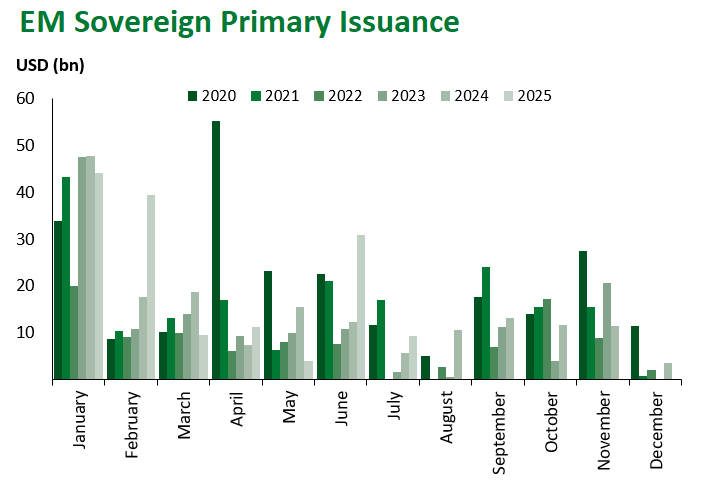
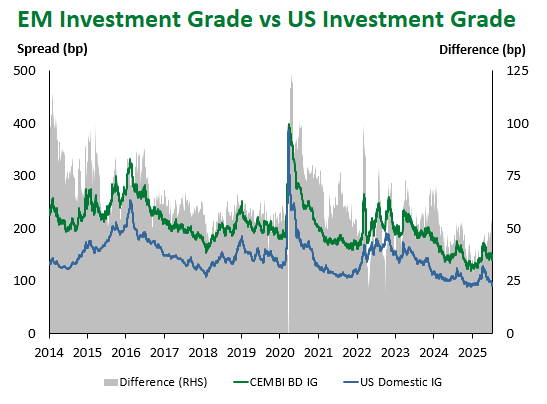
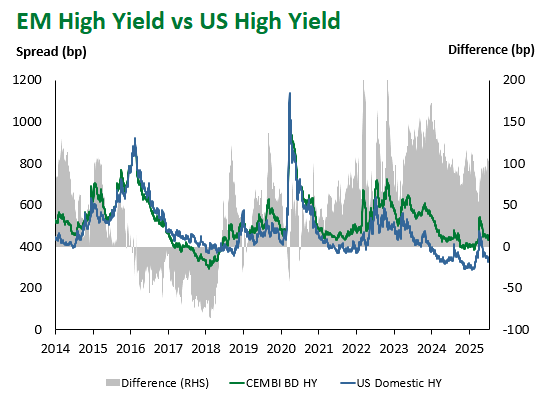

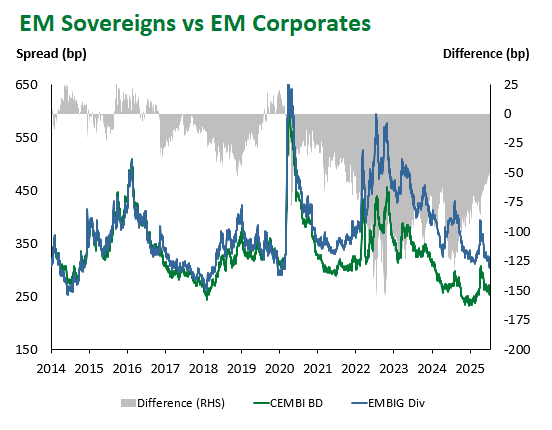
Emerging Markets Flows
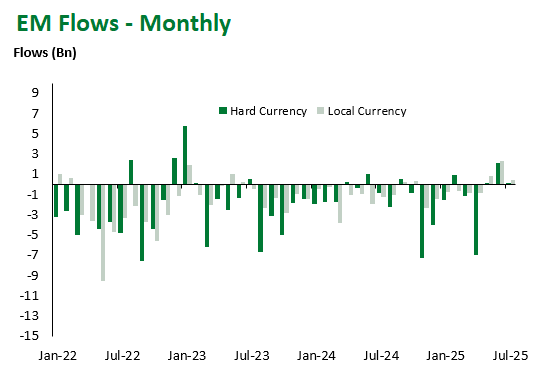
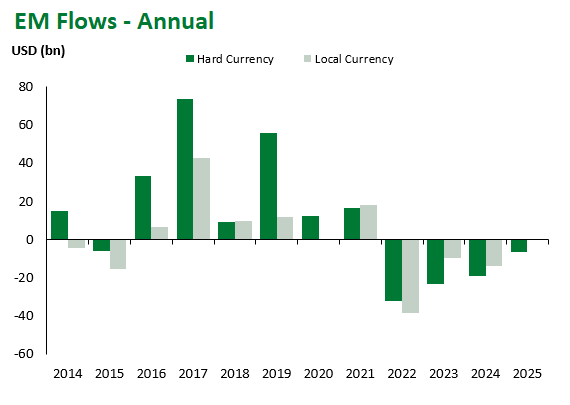
Source for graphs: Bloomberg, JPMorgan, Gramercy. As of July 11, 2025.
For questions, please contact:
Kathryn Exum, CFA ESG, Director, Co-Head of Sovereign Research, [email protected]
Petar Atanasov, Director, Co-Head of Sovereign Research, [email protected]
This document is for informational purposes only. The information presented is not intended to be relied upon as a forecast, research or investment advice, and is not a recommendation, offer or solicitation to buy or sell any securities or to adopt any investment strategy. Gramercy may have current investment positions in the securities or sovereigns mentioned above. The information and opinions contained in this paper are as of the date of initial publication, derived from proprietary and nonproprietary sources deemed by Gramercy to be reliable, are not necessarily all-inclusive and are not guaranteed as to accuracy. This paper may contain “forward-looking” information that is not purely historical in nature. Such information may include, among other things, projections and forecasts. There is no guarantee that any forecasts made will come to pass. Reliance upon information in this paper is at the sole discretion of the reader. You should not rely on this presentation as the basis upon which to make an investment decision. Investment involves risk. There can be no assurance that investment objectives will be achieved. Investors must be prepared to bear the risk of a total loss of their investment. These risks are often heightened for investments in emerging/developing markets or smaller capital markets. International investing involves risks, including risks related to foreign currency, limited liquidity, less government regulation, and the possibility of substantial volatility due to adverse political, economic or other developments. References to any indices are for informational and general comparative purposes only. The performance data of various indices mentioned in this update are updated and released on a periodic basis before finalization. The performance data of various indices presented herein was current as of the date of the presentation. Please refer to data returns of the separate indices if you desire additional or updated information. Indices are unmanaged, and their performance results do not reflect the impact of fees, expenses, or taxes that may be incurred through an investment with Gramercy. Returns for indices assume dividend reinvestment. An investment cannot be made directly in an index. Accordingly, comparing results shown to those of such indices may be of limited use. The information provided herein is neither tax nor legal advice. Investors should speak to their tax professional for specific information regarding their tax situation.
